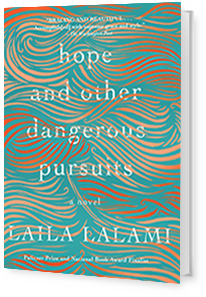Hope and Other Dangerous Pursuits is a popular book club selection. Below is the readers’ guide:
1. How do the primary characters—Murad, Halima, Aziz, and Faten—see themselves before they attempt to enter Spain? Who are they, in their own minds? Who have they become by the novel’s closing scenes?
2. What is the effect of the novel’s time line? What is it like to read “Before” after reading the prologue, which reveals the trip’s outcome for the main characters? Would you have fled Morocco if you had been in their shoes?
3. What accounts for the friendship between Noura and Faten in “The Fanatic”? Is Noura simply going through a natural rebellion against her parents, or is there a greater significance to her rejection of them? How does her conversion speak to the animosity between religious and secular movements within Moroccan society, and within the Arab world in general? How does it reflect struggles between Islamic extremists and the secular West? How do these conflicts compare with religious conflicts in the United States, such as the fight over whether or not to use the Bible in courtrooms?
4. Should Halima have trusted the judge in “Bus Rides”? Does she live in a world in which divorce (and family law in general) are politicized, or is her dilemma strictly a consequence of culture? Do culture and politics mirror each other?
5. In the prologue, why does Aziz succeed while the other passengers do not? What sets him apart? What does his financial success in Spain cost him? How is his dream for the future different from his wife’s?
6. Why, ultimately, is the future so limited for Murad and others like him? What marketable skills does Murad demonstrate throughout the novel, and how would they benefit him in a more prosperous country? What ensures a country’s economic prosperity?
7. Is it Larbi’s fault that Faten has become a sort of odalisque (concubine) in “The Odalisque”? What might her fate have been if she had not been expelled from the university?
8. As Faten wonders whether Noura kept the hijab, she decides that she “was probably still wearing it. She was rich; she had the luxury of having faith …Noura also had the luxury of having no faith.” How do money and class factor into the novel’s story lines? What distinctions are made between those can legally go abroad, through universities or jobs in high-end industries, and those who cannot?
9. Look up the definition of “Moor” in multiple dictionaries. How do the definitions compare? What did you think the word meant before reading this novel?
10. Locate the Strait of Gibraltar, Tangier, and Casablanca on a map. What observations can you make about this region, in terms of size or topography? What did the novel teach you about the geography of this gateway between Europe and North Africa?
11. Murad makes part of his scant living by capitalizing on Westerners’ desires to retrace the steps of Paul Bowles or other Western authors who perpetuated the exoticism of Morocco. How do outsiders treat Morocco in fiction? How does Laila Lalami characterize her homeland?
12. How does Murad’s rendition of the enchanted-rug story serve as a metaphor in the novel’s closing scenes? What is exchanged between him and the tourists throughout “The Storyteller”?
13. Discuss the novel’s title. What is at the root of the characters’ hopelessness? What are their least dangerous pursuits?
14. What immigration stories exist in your family history? Can you envision a world so free of poverty and injustice that no one would feel compelled to risk his or her life for immigration? If you were forced to relinquish your current citizenship and flee to another nation, where would you want to go? What cultural price would you have to pay?
